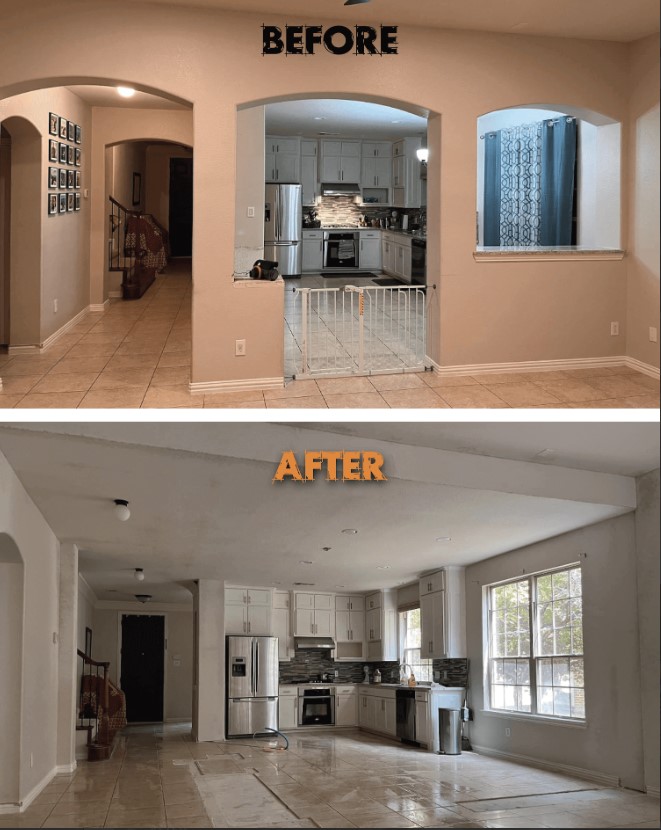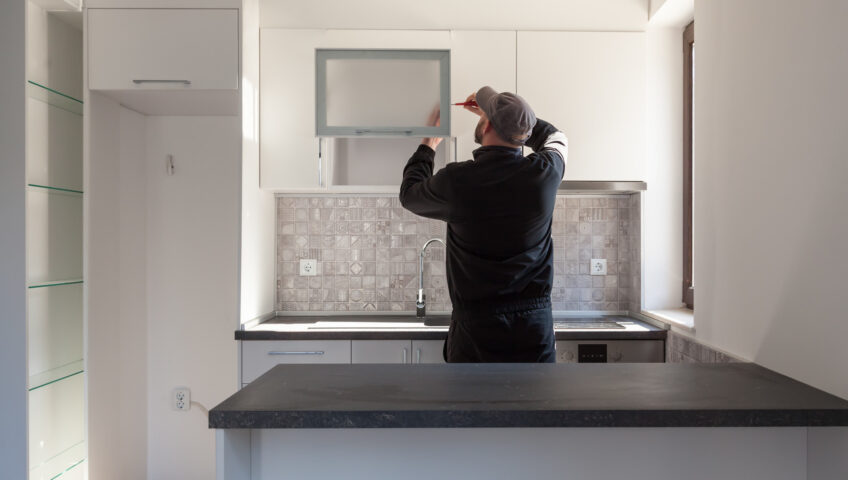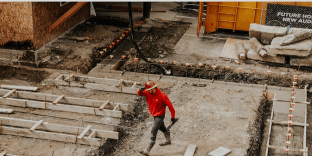
This Is How to Tell If a Wall Is Load Bearing
According to the latest Remodeling Impact Report from the National Association of REALTORS®, 35% of owners state better functionality and livability as the most important reason for completing a remodel.
One way to improve livability in the home is to change the flow and layout. Sometimes, the best way to do so is by knocking down a wall.
However, accidentally knocking down a load-bearing wall can have disastrous consequences. When it’s not done properly, it can cause structural issues, uneven floors, sagging ceilings, sticking doors, cracks, and more. If you’re wondering how to tell if a wall is load bearing, use these tips.
The Purpose of a Load-Bearing Wall
If you’ve ever watched a home renovation show or talked about remodeling, you’ve probably heard the term, but what is a load-bearing wall?
These crucial parts of your home support the weight of a roof structure or floor above them. A load-bearing wall can support a great deal of weight. Accidentally removing one without taking the proper steps to support the floor and roof can cause structural issues, which we’ll talk about next.
Partition walls, on the other hand, are dividers. They hold themselves up, and they also support interior doors.
Not all partial walls are partitions. Some partial walls may also be load-bearing.
What Happens if You Remove One?
It’s possible to remove load-bearing walls. However, you need to do it the right way. We can’t stress enough that this isn’t a DIY project.
In most cities, you need a building permit for renovations. You may also need separate permits if the load-bearing wall contains electrical wires or plumbing. A professional load-bearing wall removal contractor will know all local requirements.
When removing walls, you may encounter asbestos. Homes built before 1990 may have asbestos in the walls, and it’s vital to hire a professional to remove it. Asbestos exposure can cause severe, even life-threatening health problems and issues with breathing.
Asbestos is also a known human carcinogen and can cause mesothelioma and possibly other types of cancer. That’s why it’s vital to leave wall removal to the professionals.
Additionally, a load-bearing wall requires the use of supports before it’s removed. Temporary support beams or walls keep your house from sagging or collapsing.
Once the wall has been removed, you need to replace that support structure with another. Common solutions are beams and posts. It’s also common to combine the two.
How to Tell if a Wall Is Load Bearing
There are several ways you can determine if a wall is a load-bearing one or not. You can do this yourself before you call a wall removal service to inspect your home.
The easiest way is to look at the blueprints. If you don’t have the blueprints, you can examine your home for telltale signs. Any homeowner can take these steps, as long as you know what to search for, though it may require a look in the attic and basement.

It’s One of the Exterior Walls
The exterior walls of a building are almost always load-bearing. Older homes used all exterior walls to support the structure, while newer houses only use the front and back walls.
If you live in a home that was previously modified, your current exterior walls may not be your original exterior walls. Contact the builder if you can to determine which of them were designed as load-bearing walls.
It Runs Perpendicular to the Joists
Any wall located perpendicular to the joists is load-bearing. In some instances, a wall directly under a single joist that runs parallel to it can be load-bearing.
It’s Above Another Wall or Support Structure
One of the ways to tell if a wall is load bearing or not is to head downstairs to the basement or crawlspace. Check and see if another wall is directly below the wall in question. There may also be a beam or column.
If you notice either of these signs, it’s a load-bearing wall.
Another sign is seeing steel girders. Support girders transfer a home’s weight to the exterior walls. Wooden or metal supports along a ceiling and wall are a sign of load-bearing walls.
It’s More Than Six Inches Thick
Particularly thick walls are usually load bearing. Any wall that’s wider than six inches is likely supporting the structure of your house.
Similarly, walls located in the middle of a building are often in place to support the weight of the roof.
It’s a Foundation Wall
A foundation wall of concrete or masonry is there as a support structure for the house. Therefore, these walls are always load-bearing. If you see a masonry wall and it isn’t decorative or a type of manufactured veneer, it’s likely there for support.
The Wall Ends With Columns or Supports
In most cases, any wall that ends with supports or columns is a load-bearing one. These walls might also end in large, boxy sections designed to conceal support beams.
Find the Beams
Most beams are behind drywall. However, the beams can also tell you which walls are load-bearing.
You can see the beams in unfinished areas of the house, such as unfinished basements or attics. Blueprints and construction documents can prevent you from having to tear down any drywall to find out.
If you don’t have the blueprints or building plans—and many homeowners don’t—you can still request a copy. Contact your county clerk’s office, the original owners, or the contracting company to do so.
One mistake homeowners often make is assuming structural features are simply decorative. That’s why it’s always best to contact a contractor. Whether it’s wall moving or structural remediation, load-bearing wall removal experts know what to look for.
Benefits of Removing a Load-Bearing Wall
So you now know what to look for when searching for load-bearing walls. But what are the benefits of doing so, and should you?
A Better Flow
If your current home’s layout isn’t working for you, knocking down a wall can significantly improve the look and feel of your space. Many homeowners look for an open concept or partially open concept to entertain guests and keep a closer eye on the kids. Plus, you’ll have more room to move, and your home has a more open and airy feel.
If the layout you have now seems closed off, removing a wall can make a huge difference.
Take a look at load-bearing wall removal before and after pictures to see exactly what we mean!
More Light
Closed-off areas of the house can look and feel dark. You want to invite natural light into the home, and a more open concept look can do that.
Without a wall in the way, light can travel from room to room, making the entire area brighter. Both natural and artificial lighting does this. Either way, you can eliminate the problem of dark rooms in the house.
Your Home Looks Bigger
Removing a wall can make your home appear larger, which benefits you in several ways. Although you’re not adding any square footage, you can make it look like you have. Removing a wall can trick the eye into thinking you have more space, similar to using light colors and mirrors.
Not only is the area more open and easy to access, but removing a wall can improve the value of your house as well. Buyers will appreciate the look and flow of the house.
Don’t DIY It
We’ve said it before, but it bears repeating—knocking down a load-bearing wall without taking the proper precautions and placing supports first can cause lasting damage. While you can easily check to see if a wall is a supporting structure, removing a load-bearing wall is best left to the professionals.
Houses built before 1990 can contain walls with lead paint and asbestos, requiring remediation. Walls might also contain fixtures, such as electrical wires and plumbing. These aren’t issues you want to mess around with if you don’t know what you’re doing.
Also, removing load-bearing walls requires a permit.
A building professional knows how to spot a load-bearing wall, whether it can be safely removed, and how to do so. They’ll know all the local laws and requirements for the renovation, including the required permits and what to do if you encounter an issue like asbestos.
To learn more about the process of removing a load-bearing wall, check out how we do it in our video series.
If you’re unsure whether the wall you want to remove is load-bearing, consult with us first. We can help you go over your options.
Common Mistakes to Avoid When Removing a Load-Bearing Wall
When planning to remove a load-bearing wall, it’s easy to overlook critical factors that could result in costly and damaging mistakes. One of the most common errors homeowners make is underestimating the complexity of the task. Many people believe that simply removing a wall will open up space and improve the home’s flow, but the structural consequences can be severe if not handled properly.
Another mistake is neglecting to check for hidden utilities, such as electrical wiring, plumbing pipes, or gas lines that might be embedded within the wall. Cutting into these systems without proper knowledge can lead to leaks, electrical hazards, and even fires. Always ensure that any utilities are properly rerouted before you begin.
Lastly, relying on visual inspection alone to determine if a wall is load-bearing can be deceptive. As discussed earlier, certain walls may look non-essential but still play a crucial role in supporting your home’s structure. Always consult with a professional before making irreversible changes to your home’s framework.

The Long-Term Value of Properly Removed Load-Bearing Walls
While the process of removing a load-bearing wall might seem like a daunting task, it can offer significant long-term value if done correctly. When handled by experienced professionals, removing a load-bearing wall opens up endless possibilities for redesigning your space, creating a more functional and modern layout. This can dramatically increase the overall livability of your home.
Beyond just aesthetics, properly removing a load-bearing wall can also enhance the resale value of your home. An open-concept design is a major selling point for many prospective buyers, especially those seeking spacious and contemporary living spaces. If done with care and expertise, it can make your home stand out in a competitive market, delivering a solid return on investment when it comes time to sell.
Additionally, modern structural enhancements like beams or columns used to replace the wall will not only support your home’s weight but also ensure that the new design stands the test of time. With proper planning, this home improvement project can be one of the best investments you make in terms of both lifestyle and property value.
How to Prepare for the Load-Bearing Wall Removal Process
Preparing for the removal of a load-bearing wall requires more than just the right tools and expertise – it involves careful planning and organization to ensure that the project goes smoothly. Before you begin, it’s crucial to consult with a structural engineer or a professional contractor who can assess the integrity of your home and determine the best course of action. They will also help you obtain the necessary permits and ensure compliance with local building codes.
Another key preparation step is to clear the area around the wall. This includes moving any furniture, covering floors and surfaces to protect them from debris, and ensuring the work area is easily accessible for the crew. Additionally, you’ll need to arrange for temporary accommodations if the project affects essential services, such as plumbing or electricity.
During the process, always keep safety as a top priority. Ensure that proper safety measures, including supports, scaffolding, and protective gear, are in place to minimize the risks associated with structural alterations. A well-prepared site will help reduce unexpected delays and ensure that the project progresses as planned, resulting in a successful outcome with minimal disruption to your daily life.
Ready to Get Started?
If you’re planning a renovation soon, whether at your own home or if you’re house flipping in Houston, make sure you use these tips. Any homeowner can figure out how to tell if a wall is load bearing, but it’s still just a guess. Before you take any walls down, contact a professional load-bearing wall removal company.
To get started on your project, reach out to us at Load Bearing Wall Pros. We serve the Plano, Woodlands, Houston, and Dallas/Fort Worth areas. We can help you out with porch column removal, wall removal, and structural remediation of all kinds.


